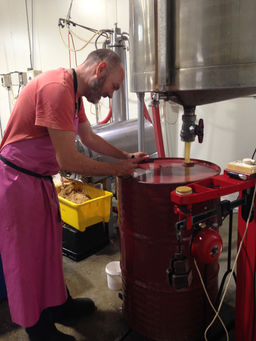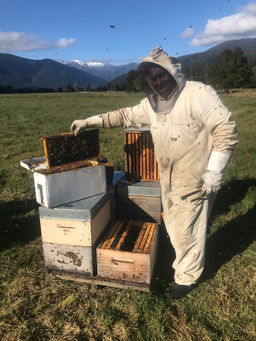PROCESSING
Lindis Honey has its own extraction plant in Cromwell, New Zealand. This has recently been expanded to cater for the increased number of hives from about 2500 three years ago to 4500 now, and plan to build up another 1000 to cope with the increased demand for pollination.
New Zealand is known for producing some the most pure, natural and distinct honey world-wide. The rural landscape holds a rich diversity of pasture and wildflower plants, which produce uniquely high quality Clover, Borage and Thyme honey known the world over.
Lindis Honey also produces Kamahi Honey from the remote world heritage area of South Westland, in New Zealands South Island.
Standards & Testing
New Zealand has stringent testing and regulatory procedures for ensuring honey is produced and processed to the highest standard of ‘Good Operating Practice’. Read more here.
The Ministry for Primary Industries works closely with beekeepers, packers and exporters to ensure the product’s integrity at all stages of production. The purchaser can have 100% certainty they are getting a pure, untreated honey with no additives.
HONEY VARIETIES
Our honey comes from the rugged ranges of Central Otago and the remote rain forests of the West Coast of New Zealand. All our honeys are 100% natural, free from impurities, additives, antibiotics and added sucrose, and possess many health benefits.
Comb honey production is also available by prior arrangements.
CLOVER
Clover honey is one our NZ’s most popular honeys, due to its mild creamy flavour and intense sweetness. It is a very versatile honey and contributes a delicate sweetness to cooking, baking, and sauces. It is also easy to enjoy as a spread with fresh breads, cheese and crackers.
Clover honey is produced from a range of wild pasture clover plants, the main one being Trifolium repens. Clover is very beneficial to pasture farming, and the South Island of New Zealand produces some of the purest clover honey, making it very light in colour (10-35 on the pfund scale).

THYME
Thyme honey is a very unique honey, as it is produced from the Thyme plant (Thymus vulgaris) which has a strong distinctive herbal aroma and flavour. These unique qualities are likely to be due to the phenols found in the oil of the plant, thymol and carvacrol, which are well known for their antibacterial and antifungal properties.
The location of this plant in the Southern Hemisphere is limited specifically to the dry, arid Central Otago climate. Thyme was brought over from the Northern Hemisphere by the miners during the gold rush in the 1800’s, and became established on the surrounding north faces of the mountain ranges. It flowers in Spring, and produces a lovely purple flower. The honey is typically darker (around 105mm on the PFund scale). Specialty chefs love to use this unique honey in their gourmet foods. Just a small amount is needed to flavour cooking.
RATA
Rata are a tree species which are found in the pristine national rainforests of New Zealand, on the West Coast of the South Island. They flower during the peak of summer only once every 3 years, so their honey is a rare and desirable product.
Rata (Metrosideros) species are part of the Myrtle family, which also include eucalypts and leptospermums (Manuka sp.).


VIPERS BUGLOSS
Vipers Bugloss (Echium vulgare) is a wild flower that grows predominately on the dryer mountain sides of the South Island of New Zealand.
It can make whole hill sides a vivid blueish purple colour.
KAMAHI
Kamahi is a native tree which grows in the pristine rainforests of the West Coast of New Zealand, producing a profuse white bottle brush flower during the early summer months.
Kamahi honey has a full bodied flavour that is toffee like and creamy.
Kamahi honey’s colour is amber (30-40 on the pfund scale). Chef’s love this honey as an addition to their cooking due to its distinct after tones.

.png)











